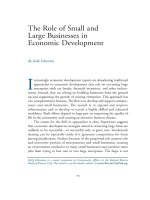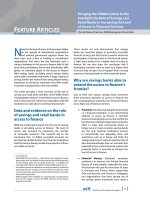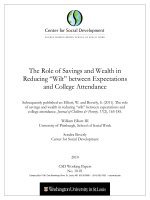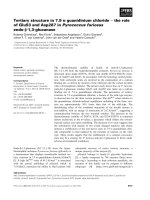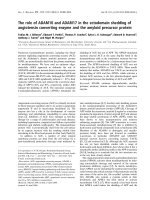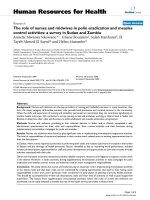THE ROLE OF TRANSFORMATIONAL LEADERSHIP BEHAVIORS IN AFFECTIVE EMPLOYEE ENGAGEMENT AN EMPIRICAL STUDY IN THE TWO INDUSTRIES OF RETAIL AND FINANCIAL SERVICES IN HO CHI MINH CITY
Bạn đang xem bản rút gọn của tài liệu. Xem và tải ngay bản đầy đủ của tài liệu tại đây (860.04 KB, 84 trang )
1
The Role of Transformational Leadership Behaviors in Affective Employee
Engagement: An empirical study in the two industries of retail and financial
services in Ho Chi Minh City
ABSTRACT
According to many previous studies, the effective leaders are one of the most
important factors in engaging the employees to the organization; leveraging the
human capital to create sustainable competitive advantage for the organization
efficacy and leading to organizational benefits. The purpose of this study was to
investigate the relationship between transformational leadership behaviors and
affective employee engagement and to examine their impact on employees’ level of
affective engagement in private and foreign-owned companies in Ho Chi Minh
City. Total participants in the research were 320 full-time employees from the
industry of retailing and financial services in Ho Chi Minh City. The majority of
employees have worked in private organizations (55.3%) and followed by foreign-
owned companies (44.7%); in financial services (53.4%) and in retail industry
(46.6%) respectively.
The findings of the study indicated that transformational leadership behaviors
including intellectual stimulation, idealized influence behaviors and individual
consideration have significant and positive correlations with affective employee
engagement. Among the independent variables, individual consideration is found to
be the most important factor in driving affective employee engagement.
The research results have contributed to the literature and provided more evidences
for the managers in their decisions of their workforce planning. However, the
sample for the research is still limited due to the application of convenient sampling
method and surveyed only in Ho Chi Minh City. Therefore, the generalization is not
2
so high; the study might have not covered all the demographic factors; and also
some other important variables were not considered all due to the scope of the
study. All the restrictions will motivate the next researchers in this interesting topic.
3
ACKNOWLEDGEMENTS
I am deeply grateful to my advisors, Dr. Nguyen Huu Lam and Dr. Nguyen Dinh
Tho for the guidance and comments through the process of completing this thesis.
Without the support and encouragement from Dr. Lam and Dr. Tho, the thesis
might not be possible in meeting the requirements and expectations of the research.
I also extend my thanks my classmates in sharing with me the ideas; store managers
in Crescent Mall in district 7 and MBA students at the University of HCMC
Economics in filling in the questionnaires.
I would like to acknowledge the support and encouragement of my family in the
concession of time, money and effort to complete the program. Most of all, I would
like to be grateful to my Buddha for giving me good health, optimism and strength
to finish the study.
4
TABLE OF CONTENTS
ABSTRACT 1
ACKNOWLEDGEMENTS 3
TABLE OF CONTENTS 4
CHAPTER ONE: INTRODUCTION 8
1.1 BACKGROUND OF THE STUDY 8
1.2 STATEMENT OF THE PROBLEM 10
1.3 OBJECTIVES OF THE STUDY 11
1.4 RESEARCH QUESTIONS 12
1.5 SIGNIFICANCE OF THE STUDY 12
1.6 SCOPE OF THE STUDY 13
1.7 STRUCTURE OF THE STUDY 13
CHAPTER TWO: LITERATURE REVIEW 14
2.1 INTRODUCTION 14
2.2 THE CONCEPT OF LEADERSHIP 15
2.3 THE EVOLUTION OF LEADERSHIP THEORIES 15
2.4 LEADERSHIP MODEL 17
2.5 FIVE DIMENSIONS OF TRANSFORMATIONAL LEADERSHIP
BEHAVIORS 18
2.5.1 Idealized influence (Attributes) (IIA): leaders instill pride and build trust
18
2.5.2 Idealized influence (Behaviors) (IIB): leaders emphasize collective sense
of mission, talk about values and beliefs 18
2.5.3 Inspirational motivation (IM): leaders communicate and express
enthusiasm, optimism, confidence, and emotional appeals. 18
2.5.4 Intellectual stimulation (IS): leaders stimulate followers to view the
world from new perspectives; encourages problem solving, critical thinking
and creativity. 18
2.5.5 Individual consideration (IC): leaders develop, coach, and teach each
follower to grow individually by paying attention to individual needs, desires
and assigning projects. 18
2.6 THE CONCEPT OF EMPLOYEE ENGAGEMENT 19
2.7 THE EVOLUTION OF EMPLOYEE ENGAGEMENT 20
2.8 TWO DIMENSIONS OF AFFECTIVE EMPLOYEE ENGAGEMENT 21
2.9 THE RELATIONSHIP BETWEEN TRANSFORMATIONAL
LEADERSHIP BEHAVIORS AND EMPLOYEE ENGAGEMENT 22
2.10 RESEARCH MODEL AND HYPOTHESES 24
CHAPTER THREE: RESEARCH METHODOLOGY 26
3.1 QUALITATIVE RESEARCH 26
3.1.1 Sampling 26
3.1.2 Data collection and In-depth interview 26
3.2 QUANTITATIVE RESEARCH 27
5
3.2.1 Response rate and sample size 27
3.2.2 Data sources and type 29
3.2.3 Data gathering instruments 30
3.2.3.1 Multifactor leadership questionnaire 30
3.2.3.2 Affective employee engagement questionnaire 31
3.2.4 Independent and dependent variables of the study 32
3.2.5 Data analysis and presentation procedures 33
CHAPTER FOUR: RESULTS AND FINDINGS 34
4.1 DEMOGRAPHIC CHARACTERISTICS OF THE PARTICIPANTS 34
4.2 DESCRIPTIVE STATISTICS FOR TRANSFORMATIONAL
LEADERSHIP BEHAVIORS AND AFFECTIVE EMPLOYEE
ENGAGEMENT 36
4.2.1 Employees perception to Transformational leadership behaviors 37
4.2.2 Employees perception to their organizational engagement 37
4.3 THE RELATIONSHIP BETWEEN TRANSFORMATIONAL
LEADERSHIP BEHAVIORS AND AFFECTIVE EMPLOYEE
ENGAGEMENT 38
4.4 SCALE ASSESSMENT 40
4.4.1 Cronbach Alpha 40
4.4.2 Exploratory Factor Analysis (EFA) 42
4.4.2.1 Independent variables 43
4.4.2.2 Dependent variables 44
4.5 CORRELATION AND REGRESSION ANALYSIS 44
4.5.1 Correlation analysis 44
4.5.2 Regression analysis 45
4.5.2.1 Assessment of the model 45
4.5.2.2 Testing of the hypotheses 49
4.6 RESULTS AND DISCUSSION 51
4.6.1 Regression analysis 51
4.6.1.1 Intellectual stimulation 51
4.6.1.2 Idealized influence behaviors 52
4.6.1.3 Idealized influence attributes and inspirational motivation 52
4.6.1.4 Individual consideration 52
4.6.2 Industry analysis 53
4.6.3 Discussion of the results 53
4.6.4 Summary 54
CHAPTER FIVE: DISCUSSION, RECOMMENDATION AND CONCLUSION 55
5.1 CONCLUSIONS 55
5.2 THE CONTRIBUTIONS OF THE STUDY 56
5.2.1 Contributions to the literature 56
5.2.2 Contributions to the practices 56
5.3 RECOMMENDATIONS 57
5.3.1 Recommendations for the organizations and managers in Ho Chi Minh
City 57
6
5.3.2 Recommendation for future research 59
5.4 LIMITATIONS OF THE STUDY 60
REFERENCES 61
Appendix A: Total Variance Explained 66
Appendix B: Rotated Component Matrix
a
67
Appendix C: Total Variance Explained 68
Appendix D: Rotated Component Matrix
a
69
Appendix E: KMO and Bartlett's Test 69
Appendix F: KMO and Bartlett's Test 69
Appendix G: ANOVA
a
70
Appendix H: Histogram Dependent Variable AC 70
Appendix I: Normal P-P Plot of Regression Standardized Residual Dependent
Variable AC 71
Appendix J: Scatterplot Dependent Variable AC 72
Appendix K: ANOVA
a
72
Appendix L: Histogram Dependent Variable SC 73
Appendix M: Normal P-P Plot of Regression Standardized Residual Dependent
Variable SC 74
Appendix N: Scatterplot Dependent Variable SC 75
Appendix O: Questionnaire (in English) 76
Appendix P: Questionnaire (in Vietnamese) 81
7
LIST OF TABLES
Table 1: Location for paper survey, sample size and response rates 28
Table 2: Independent and Dependent variables 32
Table 3: Summary of Employees’ profile 35
Table 4: Mean and Standard Deviations of Transformational Leadership Behaviors
and Affective Employee Engagement for employees’ responses 36
Table 5: Pearson correlation matrix between transformational leadership behaviors
and affective employee engagement dimensions 39
Table 6: Cronbach Alpha 41
Table 7: Result of EFA for Independent variables 43
Table 8: Result of EFA for Dependent variables 44
Table 9: Correlation analysis 45
Table 10: Summary (AC) 46
Table 11: Summary (SC) 46
Table 12: Anova (AC) 46
Table 13: Anova (SC) 47
Table 14:Profile of Independent variables 47
Table 15: Profile of Independent variables 48
Table 16: Summary of results of hypotheses 50
Table 17: Industry analysis 53
LIST OF FIGURES
Figure 1: Proposed Research Model 24
8
CHAPTER ONE: INTRODUCTION
1.1 BACKGROUND OF THE STUDY
In Vietnam News (2002), it showed that:
More than 43% of employees in Vietnam express high levels of commitment
to both their job and the company they work for. In its global employee
commitment report 2002 Taylor Nelson Sofre says the commitment
percentage in Vietnam is higher than the average in the Asia-Pacific region
and Europe, but slightly lower than in the United States and Latin America.”
And then in Thanhnien News (2008), it is suggested that:
Vietnam needs more skilled workers since its WTO accession. The survey by
Grant Thornton, a global accounting, tax and business advisory firm which
involved over 7,800 privately held businesses in 34 countries shows that 84
percent of Vietnamese companies focus on recruiting and retaining staff,
compared to a global average of only 59 percent. Vietnamese companies
focus more on attracting and retaining employees than do companies
elsewhere.
Employee retention is considered the greatest challenge for businesses in Vietnam
and becomes a hot topic for discussions for any workshops of human resource
managers. Vietnamese employees aggressively accelerate their career to better
9
positions, challenging jobs and better pay. In a survey of Navigos Group, the
leading and largest executive recruitment solution provider reported in Vietnam
Plus (2010) “63,8 percent of respondents from 168 companies operating in Vietnam
including foreign-invested ones ranked the employee retention as the number one
human resource challenge in 2010”. And it also confirmed “getting the right people
into the right job with the right skills and to have them stay and grow are missions
which will keep human resource personnel busy in 2010. As long as this is the fact,
employee retention is hard work.”
According to Towers Watson (2011) in a briefing of engagement indicator survey,
Vietnam labor market has experienced a fierce talent war in which Vietnamese
employers are trying to engage their talent through some employee engagement
programs. In the Towers Watson’s data, it also showed that “employee engagement
levels in Vietnam have remained steady over the last five years (currently 78%
favorable) and higher than employee engagement levels in the overall Asia Pacific
Region (currently 74% favorable). However, employee intent to continue working
for their current companies is lower in Vietnam (54%) compared to Asia Pacific
(61%). In other words, the war for talent is fiercer in Vietnam than elsewhere in
Asia Pacific because employees are at higher risk of leaving.”
It is clear evidence that employee engagement has become one of the most leading
priorities for human resource practitioners and senior managers in the organization
today in Vietnam. It is also the role of HR managers and line mangers to understand
what are the critical factors affecting employees to get their high commitment to the
company. Based on that, the managers come up with strategic action plans to
engage their employees into the sustainability of the organization. These
requirements from the reality are really urgent for the managers in Vietnam to deal
with them in their daily managerial works.
10
1.2 STATEMENT OF THE PROBLEM
Nowadays, the workplace changes day by day and requires products and services to
keep in line with this demand. In order to remain competitive, employee
engagement is one of the most important factors in the face of these pressures.Since
employee engagement is strongly correlated to the leadership behaviors of direct
mangers and this concerns a focus on improving the quality of leadership in
achieving greater employees to engage to the organization and its sustainable
growth, and the profitability as well. Many researchers have revealed that employee
engagement and leadership behaviors are of crucial determinants in the
organizational success. However, leadership is one of the least understood concepts
in the corporate world and the term of employee engagement should also be
considered in many dimensions to result in a full picture of this relationship.
Beverly and John (2008) shows indisputable links between employee engagement
and various measurements of financial success in which a US survey of 24 publicly
listed traded companies with a total of over 250,000 employees over the last 5 years
recognized the stock prices of 11 companies with highest engagement increased an
average of 19.4% in comparison to only 8% of those in the same industries. Several
surveys also reveals that companies with high employee engagement levels
experienced a higher operating margin, net profit margin, revenue growth and
earnings per share than those with low employee engagement.
It is clear that employee performance or behavior on the job is influenced by his or
her immediate manager and its positive relationship will be essential to
strengthening employee engagement. So, to improve the quality of leadership and
management can be the most important step in keeping the employee committed to
the organization.
11
On the contrary, engagement is also complicated and continuous for further
research then it requires a simultaneous solution as the employees can be
emotionally engaged, cognitively engaged or physically engaged.
According to Towers Watson (2012), the voluntary turnover rate in Vietnam was
15,8% in 2010 and 13,1% in 2011. The main reason is due to the conflicts and
disagreement with their direct managers’ behaviors. Academicians, researchers and
practitioners have highlighted the significant influence that managers can have on
engagement levels of the employees. Effective managers can have more engaged
staffs and the quality of the relationship between a manager and employees is one of
the most crucial factors driving engagement. Towers Perrin (2006, as cited in
Gemma and Carl, 2009) posits that “many of the factors that influence employee
engagement and retention are factors directly and indirectly within the manager’s
control.”
Many previous researches have demonstrated the positive relationship between
leadership behaviors and employee engagement. However, the number of studies
conducted in Vietnam in general and in specific organizations or industries are
lacking and limited. Therefore, this research is considered important to test the link
between transformational leadership behaviors and affective employee engagement
in the industry of retail and financial services in Ho Chi Minh City and also to
explore employees’ perceptions on these behaviors.
1.3 OBJECTIVES OF THE STUDY
The research is to explore the relationship between transformational leadership
behaviors and affective employee engagement in the industry of retail and financial
services in Ho Chi Minh City. To achieve the goal, the specific objectives of the
study are:
12
To examine the relationship between transformational leadership behaviors
and two dimensions of affective employee engagement.
To identify the employees’ perceptions about the transformational leadership
behaviors and two dimensions of affective employee engagement.
1.4 RESEARCH QUESTIONS
Specific research questions are:
1) What are the perceptions of employees in the industry of retail and financial
services about transformational leadership behaviors and two dimensions of
affective employee engagement?
2) What is the relationship between transformational leadership behaviors and
two dimensions of affective employee engagement?
1.5 SIGNIFICANCE OF THE STUDY
Firstly, the result of the research is important to bring the awareness to the
managers in Ho Chi Minh City about the determinant variables in influencing the
engagement level of the employees in their organization.
Secondly, it will be useful as the reference or guidance for the others to conduct
further studies in related topics and other organizations regards to similar problems.
Thirdly, it is believed the research can add more value to the literature on leadership
behaviors and employee engagement, especially in Vietnam setting.
13
1.6 SCOPE OF THE STUDY
The focus of this study is to examine the relationship between transformational
leadership behaviors and affective employee engagement in the industry of retail
and financial services in Ho Chi Minh City, Vietnam. Of course, the data for the
study is delimited to the surveyed employees of the two industries in Ho Chi Minh
City.
The study can also cover its limited share of the sampling frame which only
considered a particular group and therefore the results cannot be generalized to
represent for the whole industry or other various types of organizations in Vietnam.
1.7 STRUCTURE OF THE STUDY
The thesis is organized into five chapters as follows
Chapter one: presents the background of the study, describes the problem
statements, research objectives, significance of the study.
Chapter two: provides literature review.
Chapter three: focuses on the research methodology, describes data
collection and analysis methods.
Chapter four: analyses and presents the research findings by showing how
each of the questions has been answered and how the findings contribute to
the purpose of the study.
Chapter five: provides the conclusions, limitations and recommendations.
The end of the thesis includes references, appendices and questionnaires of the
survey form to collect primary data for the work.
14
CHAPTER TWO: LITERATURE REVIEW
2.1 INTRODUCTION
Leadership refers to the tools, behaviors and capability that a person needs in order
to be successful at motivating and directing others. While employee engagement
(Kahn, cited in Jessica and Helena, 2011) concerns the degree to which individuals
make full use of their cognitive, emotional, and physical resources to perform role-
related work.
When people talk about high-performing employee retention, they often focus on
financial and non-financial incentives. However, researches from all over the world
show that there is another mutual link of leadership behaviors in keeping the staff
engaged at work. All organizations expect to have engaged employees and willingly
to spend their resources to improve employee engagement. And one of the
antecedents of employee engagement is leadership behaviors.
Researchers believe that leadership is one of the most important organizational
factors having direct impact on the motivation, satisfaction and the performance of
individuals. Tichy and Cohen (as cited in Salman, Riaz, Saifullah, and Rashid,
2011) said that “the scarcest resource in the world today is the leadership talent
capable of continuously transforming organizations to win in tomorrow’s world.
The individuals and organizations that build leadership engines and invest in leaders
developing other leaders have a sustainable competitive advantage”.
Moreover, Kotter and Haskett (as cited in Salman et al, 2011) consider leadership as
a single most important factor in making organizational change and establish its
strategic direction. In reality, the relationship between the leaders and employees is
15
a causal link and has a mutual link on each other. The leader behaviors will have a
direct impact on staff performance and engagement.
2.2 THE CONCEPT OF LEADERSHIP
There is no single correct definition of leadership as various researchers explore in
different aspects and leadership is also a complex phenomenon involving the leader,
the followers and the situation. Researchers may focus on the relationships between
the leader and the followers; the physical traits, behaviors, personality; or the
situations that affect the ways the leader acts.
Leadership can be understood in different definitions as the process a leader induces
a subordinate to behave in a desired manner; direction and coordination for the
work of group members; an interpersonal relation others comply because they want
to; the process of influencing a group towards achieving the goals; or the actions
that focus resources to create opportunities (Richard, Robert, and Gordon, 2009).
2.3 THE EVOLUTION OF LEADERSHIP THEORIES
Leadership traits
The theory considers leaders to possess some abnormal abilities to set them apart,
make them different from others and bring them to success. It also supports the
leaders might obtain some universal characteristics that the others cannot. The study
of leadership is to attend to the traits of the person, also called Great Man theory
and assumes leaders are born rather than are made (Sharon, 2003).The
shortcomings of this theory are that they cannot measure the leader’s performance
and attend to different circumstances.
16
Leadership behaviors
The approach focuses on what the leaders do rather than what are their qualities. It
also considers the correlation of leaders’ behaviors, effectiveness, and task.
If the leaders can show these behaviors, they will satisfy the members, enhance the
relationship and social stability of the group.
Situational leadership
The approach considers the effectiveness of a leader to depend on some specific
situations, the nature of the work, the nature of environment, and subordinates. So it
proposes the styles of leadership might be different in different levels in the
organization.
Situation leadership also can be leadership traits or leadership behaviors depending
on the leaders’ actions or responses in a given situation.
Contingency leadership
It is to focus on the situational variables to predict the appropriate leadership styles
in comparison to the given circumstances. In the same meaning, the leadership
effectiveness is combined both the qualities of the leaders and the demands of the
situations. In order to make a good decision, the leaders have to address to
situational variables.
Transactional leadership
The model focuses on social contract between the leaders and the followers in
relation to the effectiveness; the mutual benefits which the leaders deliver to
17
followers the rewards or recognition in exchange for the commitment or loyalty of
the followers.
Transformational leadership
Transformational leadership does not aim to replace the transactional leadership but
to contribute to describe more attributes of the leaders. Transformational leaders
focus on the needs of the followers, engage them to the organization and implement
the organizational performance.
2.4 LEADERSHIP MODEL
Transformational leadership
The concept of transformational leadership was firstly introduced by Burns with the
definition of transformational leadership as a process both the leaders and the
followers promote each other to motivation, rationality, problem solving and
morality.
Transformational leaders enhance the followers’ capability by creating new
demands and values so that they can grow their performance. Moreover,
transformational leaders often challenge others for changes, extraordinary works
and drive the organization effectively. They have an important role in influencing
the organization changes; designing a very clear picture for the organization and
share the vision so that the employees can be inspired of it (Burns, 1978, as cited in
Gholamreza, Hasan, and Ali, 2009).
Transformational leaders always encourage the followers to think of new
perspectives in solving problems; help the followers to try harder their capability
and inspire them to focus on the organizational objectives. They also influence the
18
followers to attempt higher results by providing new perspectives and higher efforts
in attaining the goals. “The transformational leader asks followers to transcend their
own self-interests for the good of the group, organization, or society; to consider
their longer-term needs to develop themselves, rather than their needs of the
moment; and to become more aware of what is really important. Hence, followers
are converted into leaders” (Bass, 1990, as cited in John, 2006).
Evidences from researchers show that transformational leaders focus on the task,
value and vision (Bass, 1985, as cited in Gholamreza et al, 2009). Transformational
leaders treat each employee individually, provide them personal attention and tend
to manage through inspired motivation and individualized consideration (Burns et
al, as cited in Yueh-shian, n.d.).
2.5 FIVE DIMENSIONS OF TRANSFORMATIONAL LEADERSHIP
BEHAVIORS
2.5.1 Idealized influence (Attributes) (IIA): leaders instill pride and build trust
2.5.2 Idealized influence (Behaviors) (IIB): leaders emphasize collective sense of
mission, talk about values and beliefs
2.5.3 Inspirational motivation (IM): leaders communicate and express enthusiasm,
optimism, confidence, and emotional appeals.
2.5.4 Intellectual stimulation (IS): leaders stimulate followers to view the world
from new perspectives; encourages problem solving, critical thinking and creativity.
2.5.5 Individual consideration (IC): leaders develop, coach, and teach each
follower to grow individually by paying attention to individual needs, desires and
assigning projects.
19
The five constructs are measured by MLQ form 5X (Bass & Avolio, 1997, as cited
in Ronald and Rebecca, 2008).
2.6 THE CONCEPT OF EMPLOYEE ENGAGEMENT
Numerous definitions of employee engagement can be referred to a condition in
which the employee has an organization purpose and show their enthusiasm,
effectiveness, effort, commitment, involvement, passion to the work. In
engagement, employees tend to express themselves physically, cognitively and
emotionally during their role performances. Employee engagement also captures the
extent to which employees are motivated to contribute to the organizational success
and provide discretionary effort to accomplishing their tasks for the achievement of
organizational goals.
According to Nitin (2005), employee engagement is the level of commitment and
involvement that an employee has towards their organization and its value. An
engaged employee can be aware of business context and works to improve
performance for the benefit of the organization. Kahn (as cited in Sandeep, Mark,
Chris, Emma, and Katie, 2008) defines “employee engagement is the harnessing of
organization members’ selves to their work roles.”In addition, engagement also
relates to the degree of discretionary effort that the employees willingly apply in
their work; choose whether to contribute at minimum level of their performance or
to go beyond the minimum to offer outstanding effort (Beverly and John, 2008).
There are three components of employee engagement: cognitive engagement refers
to ‘thinking’, affective or emotional engagement refers to ‘feeling’, and behavioral
engagement refers to ‘doing’. The cognitive aspect concerns the employees’ belief
about the organization; their managers and working conditions. The emotional or
affective aspect refers to how employees feel whether they have positive or negative
20
attitudes. And the physical or behavioral aspect implies the physical energies of the
employees to accomplish their roles.
2.7 THE EVOLUTION OF EMPLOYEE ENGAGEMENT
Wave 1 (1990-1999)
This wave begins with the concept of personal engagement by Kahn (as cited in
Mary, 2011) as “the harnessing of organizational members’ selves to their work
roles; in engagement, people employ and express themselves physically,
cognitively, and emotionally during role performance”. Then Buckingham and
Coffman (as cited in Mary) come up with the definition of an engaged employee if
he or she can answer yes to all 12 questions of Gallup questionnaire.
Wave 2 (2000-2005)
This wave witnesses the emergence of many consultancy firms in measuring
employee engagement through the perceptions of work and the satisfaction with the
organization. And Harter (as cited in Mary) defines “employee engagement as a
combination of cognitive and emotional antecedent variables in the workplace. This
omits Kahn’s (1990) behavioral element represented by his physical engagement
component.”
Schaufeli and Bakker (as cited in Mary) influence the concept in reference to the
organization context and job engagement with dimensions: cognitive, emotional and
physical.
21
Wave 3 (2006-2010)
In this period, Saks extended Kahn’s viewpoint in considering both job engagement
and organization engagement. And the CIPD (as cited in Mary) with the literature
support from some academics also identifies the three dimensions of employee
engagement: “emotional engagement (being very involved emotionally with one’s
work; cognitive engagement (focusing very hard while at work); and physical
engagement (being willing to go the extra mile for your employer).”This wave also
draws the interest of many researchers such as: Macey and Schneider, Kular, Shuck
and Wollard, Attridge, Albrecht to contribute to the diversifications of the literature
review of employee engagement.
2.8 TWO DIMENSIONS OF AFFECTIVE EMPLOYEE ENGAGEMENT
Affective employee engagement comprises two components: affective commitment
and supervisory commitment.
Affective engagement is a multi-dimensional construct focusing on the individuals’
relationships with their roles, organizational commitment, job involvement and job
satisfaction. Researches from academicians and practitioners have showed a strong
correlation between the work outcomes and the line manager, leadership and
follower thinking and behavior. Therefore, affective engagement is measured by the
employee’s feelings of commitment to their immediate supervisor in particular and
the organization in general.
According to Allen and Mayer (1990, as cited in Dilys, Sarah, and Sue, 2004),
affective commitment is the most important form of commitment because it
indicates the most potential benefits for the organizations. Employees with high
affective commitment will go beyond their role and duty for the good of the
22
organization. Moreover, affective engagement is a positive feeling about doing a
good job (Kerstin, Catherine, Emma, Chris, and Mark, 2010).
Supervisory commitment engagement is also a multi-dimensional construct to
attend to the relationships between the direct supervisor and the subordinates. The
employees tend to engage to the organization if they commit to their line manager.
Researches from academicians and practitioners also provide positive correlation
between the line manager and the followers.
The construct of affective commitment is measured by Allen and Mayer’s
organizational commitment scale and the construct of supervisory commitment is
measured by Becker’s job satisfaction (as cited in Jonnie, 2009).
2.9 THE RELATIONSHIP BETWEEN TRANSFORMATIONAL
LEADERSHIP BEHAVIORS AND EMPLOYEE ENGAGEMENT
According to Hai Nam and Sherif (2011), transformational leadership lies in the
leaders’ ability to inspire trust, loyalty and admiration in followers. It builds
relationships, gives larger meaning to activities and enlists followers by focusing on
intangible qualities such as vision, shared values, and ideas.
Transformational leadership is strongly positively correlated with follower job
satisfaction, follower motivation and organizational commitment (Jessica and
Helena, 2011). In addition, transformational leadership behaviors are associated
more with positive attitudes from employees; result in higher levels of individual,
group, and organizational performance (Bass, 2003, as cited in Nichola, Matthew,
Lew, Calum, and James, 2009); look for potential motives in followers, seek to
satisfy higher needs, and engage the full person of the follower (Burns, 1978, as
cited in Priyanka and Venkat, 2000); predict higher follower OCB, employee
23
performance, satisfaction and perceived leader effectiveness (Bass & Avolio, 1990,
as cited in Caroline, 2007); and enhance job satisfaction, reduction of work
pressures and increase on employees’ morale (Dahlen, 2002, as cited in Sulieman,
Hussein, and Ayat, 2011).
Report from Lowe et al (as cited in Caroline, 2007) shows meta-analytical evidence
to support the findings that transformational leadership is effective, productive,
innovative, and satisfying to followers. Transformational leadership uses soft
influence tactics, such as inspirational appeals and ingratiation to motivate
followers (Charbonneau, 2004, as cited in Caroline, 2007).
Individuals exhibiting transformational leadership are considered to be more
effective leaders. It is also true for higher and lower level leaders in public and
private settings (Lowe et al, 1996, as cited in Sulieman et al, 2011). The ability of
the transformational leaders has an important influence on individual outcome and
perceptions of justice (Greenberg, 2003, as cited in Azman, Mohd, Hassan,
Nurhana, and Karen, 2010); serves the function to engage followers into their work
and generates task performance (Tsang-lang, Li-chu, Chih-wei, and Yi-li, 2011).
From the above-mentioned evidences, the transformational leadership behaviors
provide clear links with engagement constructs. Transformational leaders move
followers beyond their self-interest for the great good of the organization by
creating a blame-free environment and building trust in leader to enable employee
engagement (Kahn, as cited in Jessica and Helena, 2011); to engage the followers’
higher needs (Hunt, 1996, as cited in Robert and Beverly, 2000); to positively
correlate with how effective subordinates perceive leaders, how much effort they
will expend, how satisfied they are and how well subordinates perform as rated by
the leader (Hater and Bass, 1988, as cited in Cheryl, Delene, and Gert, 2003).
24
2.10 RESEARCH MODEL AND HYPOTHESES
Based on the literature review and prior research, I propose:
Research Model:
Independent variables Dependent variables
Transformational leadership behaviors Affective employee engagement
Figure 1: Proposed Research Model
H5b+
H4b+
H3b+
H2a+
H2b+
H1b+
H4a+
H5a+
H3a+
H1a+
Idealized influence
attributes (IIA)
Idealized influence
behaviors (IIB)
Inspirational
motivation
(IM)
Intellectual
stimulation
(IS)
Individual
consideration
(IC)
Affective
commitment
(AC)
Supervisory
commitment
(SC)
25
Hypotheses:
H1: Idealized influence (attributes) is related positively to both affective
commitment and supervisory commitment.
H2: Idealized influence (behaviors) is related positively to both affective
commitment and supervisory commitment.
H3: Inspirational motivation is related positively to both affective commitment and
supervisory commitment.
H4: Intellectual stimulation is related positively to both affective commitment and
supervisory commitment.
H5: Individual consideration is related positively to both affective commitment and
supervisory commitment.

